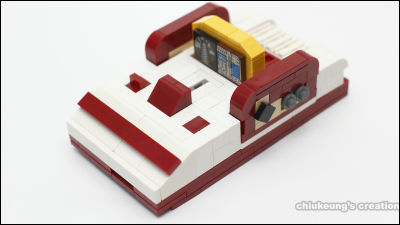Succeeded in physically scraping the NES chip and remodeling it into a Game Boy size portable game machine 'TinyTendo'

There is a project to reborn a retro game machine into a new game machine using an emulator . However, Redherring32 , who is playing with reverse engineering computer and game-related hardware, physically cuts various parts of the overseas version family computer 'Nintendo Entertainment System (NES)' and reduces it to Game Boy size. has been successful.
Hobbyist grinds down original chips by hand to make a Game Boy-sized NES | Ars Technica
https://arstechnica.com/gaming/2023/06/hobbyist-grinds-down-original-chips-by-hand-to-make-a-game-boy-sized-nes/
If you just want to 'make a Game Boy-sized Famicom', you can easily make it happen with an emulator, a single board computer Raspberry Pi , NOAC (NES-on-a-Chip), or FPGA (Field-programmable gate array). However, Redherring32 has created a game machine 'TinyTendo' that shrinks the Famicom to the size of a Game Boy using the original parts of NES without using such latest technology.
This is TinyTendo, a real hardware NES handheld that is the size of the original GameBoy.
— Redherring32 (@redherring32) May 24, 2022
This is not emulation, it is not a Pi, it is not a NOAC, and it is not an FPGA.
This is real NES hardware from a real NES.
This project will also be open sourced in a few weeks.pic.twitter.com/Csf10EYPcc
TinyTendo's game screen and the board inside look like this.
I will be doing a detailed write up on how I pulled this off soon, so stay tuned! pic.twitter.com/lOt1Uqy0d9
— Redherring32 (@redherring32) May 24, 2022
According to Redherring32, TinyTendo uses the original NES chip after physically cutting and polishing it . was cut into small pieces, and in the end the chip was 10mm x 10mm x 2mm.' In the picture it can be confirmed that the NES chip is smaller than the microSD card.
TinyTendo utilizes real NES chips that have been physically cut and ground down smaller.
— Redherring32 (@redherring32) May 24, 2022
A simple run down is that I sand away the bottom of the chip till I hit the die and leads, then I cut the chip smaller with a Dremel.
The end result is 10x10x2mm, and surface mountable.pic.twitter.com/gFcf8lN4Ez
It seems that the cut chip has been sized down to less than 7% of its original size in volume and area. As a result, it is possible to store NES's original chip on a printed circuit board smaller than Raspberry Pi 3 . All chip cutting work is done manually.
The cut chips are less than 7% of their original size by volume and area, and fit on a PCB smaller than a Raspberry Pi 3.
— Redherring32 (@redherring32) May 24, 2022
The cutting process is done entirely by hand.pic.twitter.com/F6zD4ZRlrp
TinyTendo does not use the original NES cartridge, it seems to play the game using the original cartridge created by Bucket Mouse . TinyTendo is in the center of the picture below, the original NES cartridge is on the right, and the customized cartridge for TinyTendo is on the left.
TinyTendo uses custom mini cartridges designed for me by the awesome @BucketMouseBite .
— Redherring32 (@redherring32) May 24, 2022
But the really cool thing about using real hardware for the handheld is, I could use original carts with an adapter if I wanted.pic.twitter.com/UbY4zF8YBN
In addition, TinyTendo uses the USB-C port to charge the terminal, and the voltage corresponds to 5V and 3.3V. 3.3 V is the voltage in power saving mode, and it seems that you can switch between normal mode and power saving mode using a switch. In addition, YveltalGriffin has an analog brightness control function. Also, as a tribute to the original NES, the power button uses a push button switch.
TinyTendo uses USB C for charging and has a switch to set the voltage to 5V, or 3V3 for power saving.
— Redherring32 (@redherring32) May 25, 2022
It has analog brightness control (implemented by the wonderful @YveltalGriffin ).
It also uses a latching push switch for the power button, as a homage to the original console.pic.twitter.com/beyPXqiGpu
Redherring32 said, ``One day, when I tried to see how small the NES motherboard could actually be, I was able to design a motherboard the same size as the Raspberry Pi Zero. It wasn't worth using because it was impractical,' he tweeted.
I actually messed around one day to see how small a NES motherboard could actually get, and was able to design one the same size as a Pi Zero.
— Redherring32 (@redherring32) May 27, 2022
This is way over the line where it gets ridiculous and not practical though, and isn't worth using.
(Traces are on internal layers) pic.twitter.com/6M0LZFZgb8
In addition, Redherring32 has published TinyTendo's efforts as open source on GitHub, but ``TinyTendo is a complicated project that has taken a lot of effort, and although it is a project that has been published as open source, it is still experimental to some extent. It is a typical thing,” he said. Furthermore, ``TinyTendo requires physical cutting and polishing of the original NES chip, so this is a very difficult and dangerous task.If you do not do this process correctly, you may destroy the chip. Therefore, please remodel based on TinyTendo at your own risk.'
GitHub - Redherring32/TinyTendo: An open-source portable handheld NES using real hardware
https://github.com/Redherring32/TinyTendo

Related Posts:







